I don't know whether it's an "oh, duh!" moment, or "can you believe it?" situation, but less than two weeks after returning from our Death Valley trip along the Nadeau Trail, we were headed back for more!
I was jazzed, and - a little surprisingly to me - so was @mrs.turbodb!
This time, the land area we'd cover would be larger than the last, with our plan to see several places that we've meant to visit over the last few years but that we've never gotten to - largely because there's only so much you can see on a given trip, and destinations at the end of itineraries are often left behind. Loose ends, as it were.
In the moment, those misses are a bummer - but, as I'm always advising folks who make the journey to this special park - they are blessings in disguise, because they give us a reason to return. There's always more in Death Valley to explore, and so full of excitement, we headed for several locations in the Funeral Mountains. A combination of driving and hiking, canyons and mines, we planned to visit Chloride Cliff, the Big Bell Mine, Monarch Canyon and the Inyo Mine in Echo Canyon before heading northwest to Hunter Mountain and Hidden Valley.
It'd be a full three days - if we could fit it all in. But hey, even if we couldn't, that'd be OK too - it's not like this would be our last trip to a favorite place!
We awoke on our second day of the trip to an orange glow on the horizon just after 5:45am, just south of Beatty, Nevada.
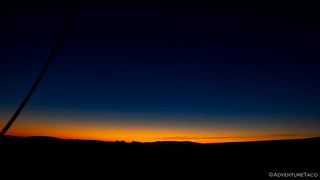
Having gotten a full three-and-a-half hours of sleep after arriving at camp in the wee hours of the morning, we were both still tired, but pulled ourselves out of bed, knowing that at this time of year, light was precious - it'd be dark again by 4:45pm in the afternoon.
Soon we were out of the tent and after a quick discussion, we decided that we'd wait a couple hours for breakfast - hopefully affording ourselves a view as we munched away. Not that what we'd woken up to was anything to complain about.

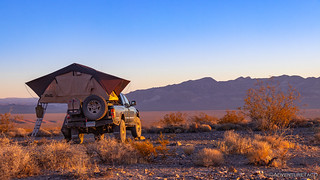
And then, we were on the road - headed west into the park and straight to our first destination: Chloride Cliff.

Perched high in the Funeral Mountains, Chloride Cliff was the first mining operation (1872) on the east side of Death Valley. Like many, its story is one of limited success and abundant disappointment over the next 90 years. Today, little is left of the mine camp - a large water tank the most prominent piece of equipment as we pulled up to the site.

This tank sat next to the foundation of the final mill that would run in these parts - a mercury treatment plant that burned to the ground after running just a small amount of ore.
From there, we wandered through what had been the the rest of Chloride City, but was now a haphazard maze of roads winding amongst the hills - just east of the Chloride Cliffs where the main mine shafts were located. What's left is in rough shape - a dugout here, old pulley parts there, and mine shafts sprinkled through it all.

I don't know why, but I'm always intrigued by dugouts.

Life here was tough on everyone and everything.

"Don't mind the road, just tunnel under it."

Several shafts had small buildings in front of the openings, to protect from snowfall, perhaps?

One of three dugouts used as boarding houses for the miners.

Twin tunnels.
In the early years, the biggest problem for Chloride Cliffs - besides the lack of valuable ore in the ground - was the high cost of transporting what was found to be processed. As such, only two years after starting, August Franklin was forced to shut down his operation - though, he continued to perform the necessary assessments in order to keep the claims alive for the next 30 years until his death. Only a few years after that, his son George would reap the largest windfall of the Franklin family, when he sold the mine for $150,000 in 1906. This turned out to be a smart move, the area failing to produce meaningful material until it was abandoned for the last time in the 1960s. (Hiking Death Valley)
Eventually, we made our way up to the top of Chloride Cliff behind town, and we were rewarded with the highlight of this far-away place: the views.

Expansive views.

Did I mention the views?

This was the perfect spot for breakfast, and as I hopped around trying to somehow capture the moment, @mrs.turbodb poured enormous bowls of cereal and covered them with fresh berries. Not a bad way to start the morning, really!
And boy, were we just getting started. The highlight of our foray up to Chloride Cliff was actually a different mine altogether. Down the west side of the mountain - in a ravine some 1,600 feet below - the Big Bell Mine is accessible only via foot, an old cableway dropping the entire distance in just under three-quarters of a mile!

We set off - the two of us - sliding our way down the rocky slope that was once a road, each of us doing our best to stay upright as we made our way towards the mine. Along the way, two-inch steel rods had been drilled and pounded into the ground, steel loops and cables used to winch the vehicles that ventured this way, now laying dormant on the mountainside.
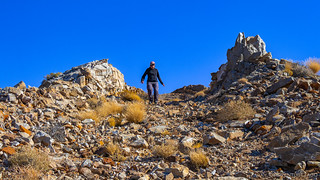
That this was once a road...hard to fathom.

A long winch up.
About 40% of the way down - as it became clear that the road only became steeper the further we went - @mrs.turbodb decided she'd had enough, and bowed out. I continued on alone, each step down a reminder that the return trip would be a workout.
But boy - oh boy - when I reached the Big Bell Mine, it was all so worth it. I mean, where to start? Perhaps with the still-hanging ore carts? Or the amazingly well preserved mill?

The difficulty of reaching the Big Bell Mine turned out to be the best thing ever. With so few people willing to make the arduous trek, it is perhaps the most well-preserved mine I've ever had the pleasure to explore. I knew immediately that my hope of a quick "take a few photos and head back to @mrs.turbodb" was an impossibility. It was time to enjoy the moment.

This old truck (right) contained a gas engine and electric winch. It was used to winch material up the cableway I'd just descended, pulling the flat trailer behind it.
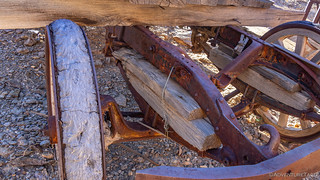
That's one way to firm up the suspension. 
I probably spent a good 15 minutes poking around the mill area of the mine site. The winches, pulleys, tanks, conveyors, and generators were all rusty but otherwise mostly complete - such a contrast to their scavanged counterparts at more popular sites.


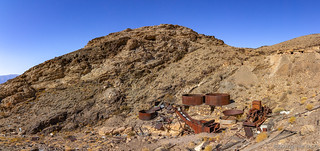

Most of the remains of this still-privately-patented site are from the 1935-1937 Coen Company era, and from the mill, I could see several tunnels on the north side of the canyon where ore was mined before being dumped into buckets that rode an aerial tramway across the bottom of the canyon. I headed that direction.

The mine shafts were nearly as interesting as the mill. An old rail line - used to convey ore to the aerial tramway - still snaked in and out of the shafts, ore bins likely pushed by hand along the narrow-gauge rail.

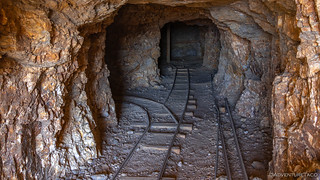

A little oil and these drills would probably work just splendidly!
And finally, a little further up the hill, the miners camp. A row building, each room appeared to be a studio-style dwelling, complete with bed frames, kitchen implements and plenty of shelving. Time has taken its toll on the camp, the roof now collapsed and the walls starting to crumble. Still, in its heyday, this would have been quite the place to work with a view!


After years of service, a well-deserved rest in a beautiful spot.
Well, I'd tootled around for a good 30-40 minutes before I finally dragged myself away from the Big Bell Mine and back up the road to @mrs.turbodb and the Tacoma. The views of Death Valley along the way were spectacular, somewhat distracting me from the average 30º slope.

After what was essentially a 1,600 vertical foot flight of stairs, I was happy to finally reach the end of the cableway, the Tacoma now just a short distance further!

And with that, we climbed back in the truck - more thankful than ever for what we've come to call "American Hiking" - the Tacoma allowing us to make quick progress with little effort as we headed back to the ridgeline, our time at Chloride Cliff and the Big Bell Mine a resounding success!

From the Chloride Cliff area, we headed north - along the usual route that people take to get to this place - toward the well-known Daylight Pass. Along the way, we stopped a few times at various mine ruins - a dugout here, an ore bin there - that kind of thing.
While we could have easily passed these up under the pretense of staying "on schedule," I think we both feel like it's important to be in the moment on a trip like this, rather than tied to some clock. The saying, "we're here, so let's take a look," is a common response when we pull up on something unexpected!



Pushing on, it was only a few more miles to Monarch Canyon, and the views along the way were brilliant in what was still only mid-morning sun. And soon, we arrived at the end of the road, about a mile down the canyon and the beginning of our next short trek.


Parked again, time to hike the wash!
Monarch Canyon is an interesting canyon in itself, but given that we were starting from the top - rather than the bottom - of the canyon, we weren't going to be able to see the impressive 110-foot waterfall. Not today, anyway - perhaps on another trip! Instead, our destination was just a half mile down canyon - the Indian Mine.
Luckily for us, navigating the most difficult part of the canyon - a 50' dry fall just below our parking spot - was easy. An old access grade to the mine conveniently bypasses this fall, the striated rock twisted and contorted over millions of years.

At its bottom, the canyon largely leveled out, making for an easy hike the rest of the way to the mine as we admired the colorful walls that rose up around us, and the tall grasses that thrived in the sun at a nearly-dry spring in the wash.


Built onto the side of the canyon, the mine's mill and the ore bin, all cling to the rock in a desperate attempt to remain standing. A long wooden ore chute that once fed ore into the ore bin is now collapsing under the weight of time, its carcass ascending the steep canyon wall to a narrow-gauge track leading to the main tunnel where mining took place.



One of the stamps still remains in the mill.
A much smaller mine site, the Indian Mine didn't take long to explore, and with both of us hungry after a morning of down-and-up hiking, we headed back to the shade of the truck for some lunch - sandwiches and chips sure to hit the spot.

It was just after 2:00pm when we pulled onto the pavement of Daylight Pass Road and headed west - down into Death Valley, with Corkscrew Peak rising up behind us.


As we ticked away the 40 miles or so we had to travel on pavement to our next foray into the Funeral Mountains, we discussed our game plan for the remaining couple hours of daylight we had for the day. My original plan had been to drive up Echo Canyon and find a spot to camp high in the Funeral Mountains, leaving any exploration of the canyon - as well as the Inyo Mine part way up - for the following morning. However, we both knew that the next day was already packed, and so if we could do a bit of that exploration on our way up-canyon on our way to camp, we'd be setting ourselves up well for the following day.
And hey, "we were here, so we might as well check it out." 

Echo Canyon is colorful from the start; no wonder it's a popular place.
Echo Canyon is the longest canyon in the Funeral Mountains, and the first several miles are simply driving up the alluvial fan that spreads out from the canyon mouth. Even in the middle of the week, several groups were already camped along the road in this popular location, making me wonder if someone would be in the spot I'd scouted further up canyon.
I didn't know it at the time, but that wasn't going to be an issue at all, as we reached the gorge that marked the mouth of the canyon.

The rock here - as it had been in Monarch Canyon - was striated and colorful, parts of it reminding me of Titus Canyon.
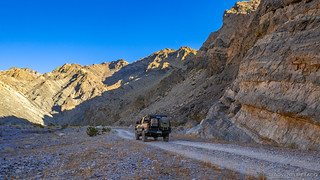
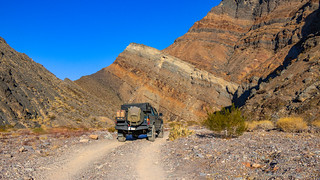
We made good time up the wash, our aired down tires and high-clearance making easy work of the few small obstacles that might keep a passenger car or less experienced driver on the alluvial fan. While there was lots of gawking out the windows as we drove through, we only made a couple of stops - the most notable at Eye of the Needle Arch - given the time, and our desire to get to camp before sundown.

Some 10 miles up Echo Canyon, we reached the Inyo Mine. It was 3:42pm - only about 45 minutes until sunset. But, we were here, now, and who knows what the situation in the morning would bring, so we decided that a quick look around was in order - probably a bit more rushed than would be ideal, but even with our best intentions, we too find ourselves working against the clock in certain situations!
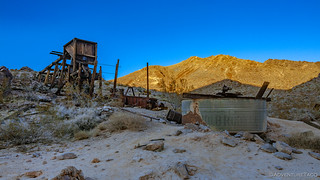
The old mill and ore bin at Inyo Mine.
The Inyo Mine's camp is a cluster of wooden buildings at the foot of the steep hillside where the gold was mined. One of the more popular mining camps in the park, it's still in remarkably good condition given the ease of access, and we enjoyed walking around to look at the various structures, comparing their current state of disrepair to that mentioned in Digonnet's book.

A small dugout, from the 1907 mining era.

Boarding house.

Unknown structure - perhaps a storage building.

The ore chute of the mill, as well as settling plates (similar to a sluice box).
Discovered in 1905, as fortune seekers were combing the mountains - hoping to find a strike as rich as the one at the Keane Wonder Mine - the area was originally staked as 20 claims that were sold to the Inyo Gold Mining Company. For two years, the company extensively developed the area and by April 1906 the main shaft was 100 feet deep with several crosscuts, and a second shaft had already been opened. With gold ore worth nearly $300/ton, in some places, the mine caught the attention of one Charles Schwab - former president of the U.S. Steel Corporation, and one of the wealthiest men in the country. While he never invested directly in the Inyo Mine, he did sink some of his personal fortune into nearby mines, lending legitimacy to the operation.
In 1907, just as the Inyo Mine geared up for the construction of its mill, a great financial panic hit the mining industry and with a lack of available funding, the company was unable to secure enough investors to keep the mine operational. Negotiations dragged on for nearly 5 years until January 1912 when the mine was finally abandoned. At the time, the company had nearly $650,000 worth of ore in sight, not a single shipment ever sent to market! (Hiking Death Valley)
With a history like that, we knew it was worth a few more minutes to head up the mine road behind camp to check out the main shaft - a 700-foot adit known as the Octaroon - and the ore chute at its mouth. While several companies had picked over the area since 1912, maybe we'd find a small nugget from that $650,000 lode gleaming in the evening sun. 


We had no such luck, and with only about 15 minutes until sunset, we hustled back into the truck and towards our planned camp site - a place much further up the middle fork of Echo Canyon. This long road runs up and over the crest of the Funeral Mountains, eventually dropping down toward the state line (and US-95) near the town site of Lee. We didn't have any plans to get to Lee, but I had scouted a camp site high in the mountains - my hope that we'd have great sunset and sunrise views. Or maybe - given the time now - just sunrise.
Plus, while I generally have a good sense of any major obstacles along our route - or at least know of their existence - I'd somehow missed the point that there was a reasonably tall dry fall in the upper section of Echo Canyon. Actually, I'd marked a "waterfall," but somehow assumed that it would be something to see along the side of the trail!  Anyway, as we drove up the wash approaching this section of trail, my comment to @mrs.turbodb was, "umm, where's the road go?"
Anyway, as we drove up the wash approaching this section of trail, my comment to @mrs.turbodb was, "umm, where's the road go?"
Of course, it all became clear as we got a little closer, and while we'd have spent more time here under normal circumstances to document the narrow passage, I knew that we'd be back in the morning, so I turned on the lockers and we made quick work of the situation so we could continue on towards our stopping point for the night.

Even with extra heavy use of the skinny pedal, it was dark by the time we pulled into the camp site I'd found as I planned this route. A bit chilly at the high elevation, we decided to divide and conquer - @mrs.turbodb making a chicken salad dinner, while I deployed the tent and replaced a skid plate bolt that'd gone missing at some point along our rather bumpy route.
As the last light of day faded from the horizon, we reflected on the gleefully full day we'd had. As always seems to happen, we'd found ourselves in a rush to "see it all," though I'd say we still did a reasonable job of being in the moment wherever we were.

With a slight breeze and cool temps, it was 7:00pm when we climbed into the tent, each of us tired from a the three hours of sleep we'd had over the last two days. Cozied up under the covers, we quickly found ourselves nodding off - smiles on our face as we looked forward to the adventures we knew were coming the next day.
The Whole Story
Love Death Valley? Check out
the Death Valley Index
for all the amazing places I've been in and around this special place over the years.


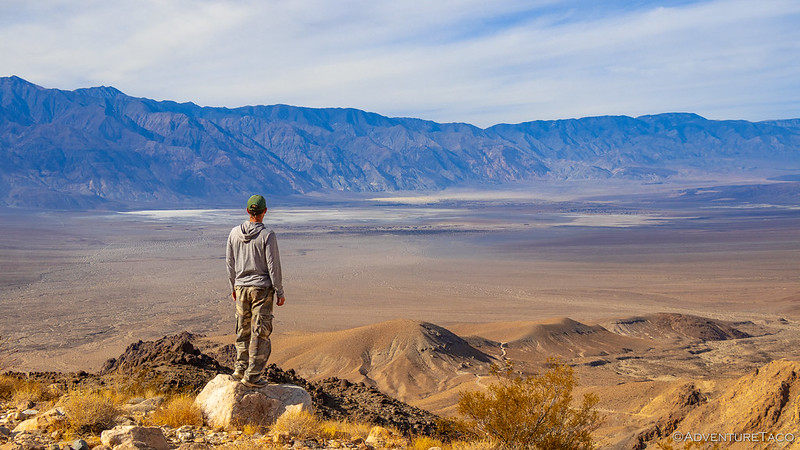

Excellent story of the off beaten path. Pictures are so crystal clear. What camera and lens did you use?
Awesome adventure, look forward to seeing your next outing.
Thanks Sharon - was a great time for sure! Camera and lens are detailed in this post here: If You Take Enough Photos, Some Are Bound to be Decent. Short answer is an 80D, but there's a lot more to it than just the camera and glass!